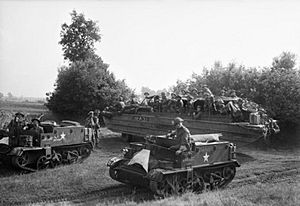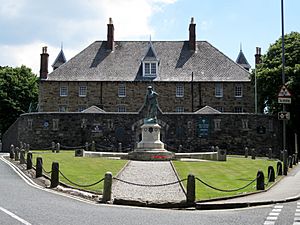Duke of Cornwall's Light Infantry facts for kids
Quick facts for kids Duke of Cornwall's Light Infantry |
|
|---|---|

Badge of the Duke of Cornwall's Light Infantry
|
|
| Active | 1 July 1881 – 5 October 1959 |
| Country | |
| Branch | |
| Type | Line infantry |
| Role | Light infantry |
| Size | 1–2 Regular battalions 1 militia and special reserve battalion |
| Garrison/HQ | Victoria Barracks, Bodmin |
| Colors | White facings |
| March | Quick: One and All |
The Duke of Cornwall's Light Infantry (DCLI) was a special kind of infantry (foot soldiers) regiment in the British Army. It existed from 1881 to 1959.
This regiment was formed on July 1, 1881. It was part of big changes in the army called the Childers Reforms. The DCLI was created by joining two older regiments: the 32nd (Cornwall) Regiment of Foot and the 46th (South Devonshire) Regiment of Foot. It also included local volunteer soldiers from Cornwall.
Over time, the DCLI joined with other regiments. In 1959, it merged with the Somerset Light Infantry to form the Somerset and Cornwall Light Infantry. Later, this group joined with more regiments to create The Light Infantry. Finally, in 2007, The Light Infantry became part of The Rifles. The Rifles still carries on the history of the DCLI today.
Contents
The DCLI's Journey Through Time
The Duke of Cornwall's Light Infantry was officially formed on July 1, 1881. This was part of the Childers Reforms, which reorganized the British Army. The 32nd Regiment became the 1st Battalion of the DCLI, and the 46th Regiment became the 2nd Battalion. Local volunteer groups from Cornwall also joined the DCLI.
Early Years: 1881–1899
During this time, the army had a system where one battalion of a regiment stayed in the UK (home) and the other served overseas. They would switch places every few years.
The 1st Battalion served in places like England, Ireland, Malta, India, and Burma. They even fought in the Tirah Campaign in 1897. The 2nd Battalion was stationed in Gibraltar, Egypt, Sudan, and then back in England and Ireland.
The Boer War and Beyond: 1899–1914
In October 1899, the Second Boer War began in South Africa. The 2nd Battalion of the DCLI arrived there in November. They fought in battles like Paardeberg and entered Bloemfontein in March 1900. They continued to fight until the war ended.
The 1st Battalion did not go to South Africa. Instead, they moved from India to Ceylon in December 1900. There, they guarded South African prisoners of war. After the war, the battalions continued to rotate between home and foreign stations. The 1st Battalion served in South Africa and England, while the 2nd Battalion was in England, Gibraltar, Bermuda, South Africa, and Hong Kong.
Reserve Battalions: 1881–1914
When the DCLI was formed, it also included reserve forces from Cornwall. These were the 3rd (Militia) Battalion and two Volunteer Battalions (1st and 2nd). These reserve soldiers usually only served in the United Kingdom.
However, during the Second Boer War, the volunteer battalions sent special companies to help the regular soldiers. They even earned a battle honor for their service. In 1908, new army changes called the Haldane Reforms happened. The militia became the "Special Reserve," and the volunteers became part of the "Territorial Force." These changes meant they could be called to serve abroad if needed.
The First World War: 1914–1918
The First World War caused the DCLI to grow a lot. Many new battalions were formed. Here are some of the DCLI battalions that fought in this huge conflict:
- 1st Battalion: Fought on the Western Front (France and Belgium) and later in Italy.
- 2nd Battalion: Served on the Western Front and then the Macedonian Front.
- 1/4th Battalion: Served in India, Aden, and Egypt.
- 2/4th Battalion: Formed in September 1914 and served in India.
- 1/5th Battalion: Stayed in the UK for a while, then went to the Western Front.
- 6th (Service) Battalion: Formed in August 1914 and fought on the Western Front.
- 7th (Service) Battalion: Formed in September 1914 and fought on the Western Front.
- 8th (Service) Battalion: Formed in September 1914, fought on the Western Front, then the Macedonian Front.
- 10th (Service) Battalion (Cornwall Pioneers): Formed in March 1915 and served on the Western Front.
Between the Wars: 1919–1939
After the First World War, the DCLI went back to having two main battalions. The 1st Battalion served in Ireland and then spent many years in India. The 2nd Battalion served in India, Iraq, Ireland, Germany, Guernsey, and then in England and Gibraltar.

The Second World War: 1939–1945
During the Second World War, the DCLI grew to seven battalions. However, only four of them served overseas: the 1st, 2nd, 5th, and 7th (Home Service) Battalion (which later became the 30th).
The 2nd Battalion was sent to France in October 1939 as part of the British Expeditionary Force (BEF). In May 1940, when the German army invaded, they were forced to retreat to Dunkirk and were evacuated back to England.
In July 1944, during the Battle for Caen in Normandy, the 5th Duke of Cornwall's Light Infantry fought bravely at "Hill 112." This hill became known as "Cornwall Hill" because the Cornish soldiers suffered many casualties there.
After the Wars: Post-1945
After the Second World War, the regiment went back to having two battalions. Between 1946 and 1954, the 1st Battalion served in places like Palestine, Cyprus, Somaliland, England, and Germany. The 2nd Battalion served in Greece from 1946 to 1948. In 1950, the 2nd Battalion joined with the 1st Battalion.
In 1954, the 1st Battalion was sent to Jamaica. Parts of the battalion also served in Bermuda and British Honduras. In 1957, these companies rejoined the rest of the battalion in England, before moving to Germany.
Finally, on October 6, 1959, the Duke of Cornwall's Light Infantry merged with the Somerset Light Infantry to form the Somerset and Cornwall Light Infantry.
Cornwall Rifle Volunteers
The Cornwall Rifle Volunteers were local groups of volunteer soldiers. The first group was formed in June 1860.
After the Second World War in 1947, the 4th and 5th battalions of the DCLI merged. They formed a new group called the 4th/5th Battalion. This battalion had its headquarters in Truro. It had companies in Penzance, Truro, Liskeard, and Bodmin.
In 1959, the Duke of Cornwall's Light Infantry merged with the Somerset Light Infantry. In 1960, the 4th/5th battalion was renamed "The Duke of Cornwall's Light Infantry (TA)." Later, in 1967, it was reorganized again. It formed new companies as part of larger army changes.
In 1968, these units became part of the new, larger regiment called The Light Infantry. Even later, in 1971, the units were reorganized again. They included companies in Truro, Camborne, and Penzance.
Over the years, these units continued to change names and structures. Today, a company still exists as "D Company" within the 6th Battalion of The Rifles. This shows the long history of the DCLI.
Regimental Museum
You can learn more about the Duke of Cornwall's Light Infantry at Cornwall's Regimental Museum. It is located at Victoria Barracks in Bodmin. St Petroc's Church, Bodmin was the regiment's church. It has memorials to soldiers and old regimental flags.
A war memorial for the regiment was put up in 1924. It was made by Leonard Stanford Merrifield. The memorial is a bronze statue on a granite base. It is a very important historical monument.
Literature
Surfing Tommies is a play written in 2009 by a Cornish author named Alan M. Kent. The play tells the story of three soldiers from the Duke of Cornwall's Light Infantry. They travel from the mines of Cornwall to the battlefields of Flanders in Belgium. There, they learn to surf with soldiers from South Africa.
Brave Soldiers: Victoria Cross Winners
The Victoria Cross (VC) is the highest award for bravery in the British military. Eight soldiers from the DCLI were awarded this medal. Some of them include:
- Lieutenant Herbert Augustine Carter
- Lieutenant Philip Curtis (his medal is in the museum)
- Thomas Edward Rendle (his medal is in the museum)
- Clement Leslie Smith (his medal is in the museum)
Other Notable Members
Many other important people served in the DCLI. One famous person was Harry Patch. He was a very old man who was the last surviving British soldier from the First World War. He passed away in 2009. Another notable member was Sir David Willcocks, a famous conductor and composer.
Battle Honours
Battle honours are special awards given to regiments for their bravery in battles. Here are some of the battles where the DCLI and its earlier regiments fought:
- From older regiments: Roliça, Vimiero, Corunna, Salamanca, Waterloo, Sevastopol.
- Early wars: Tel el Kebir, Egypt 1882, Nile 1884–85, Paardeberg, South Africa 1899–1902.
- The Great War (First World War): Mons, Ypres, Somme, Arras, Passchendaele, Cambrai, France and Flanders 1914–18, Italy 1917–18, Macedonia 1915–18, Palestine 1917–18.
- The Second World War: Defence of Escaut, Hill 112, Mont Pincon, North-West Europe 1940 '44-45, North Africa 1942–43, Cassino II, Italy 1944-45.
See also
- Duke of Cornwall's Light Infantry officers
- Duke of Cornwall's Light Infantry soldiers
- First DCLI Commonwealth War Graves Commission Cemetery, The Bluff




